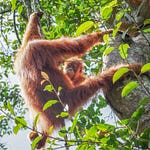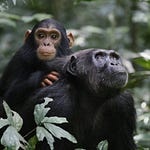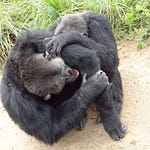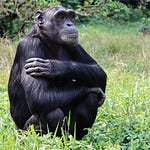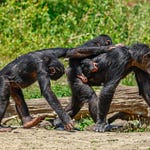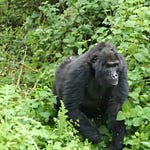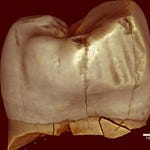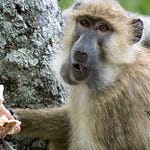Language leaves no fossils. There are no amber-preserved gestures, no stone-carved syllables. To glimpse how communication might have evolved, researchers turn instead to our closest relatives still living in forests today. Among chimpanzees in Uganda, the newest evidence suggests that mothers—not fathers—are the primary teachers of communicative style.
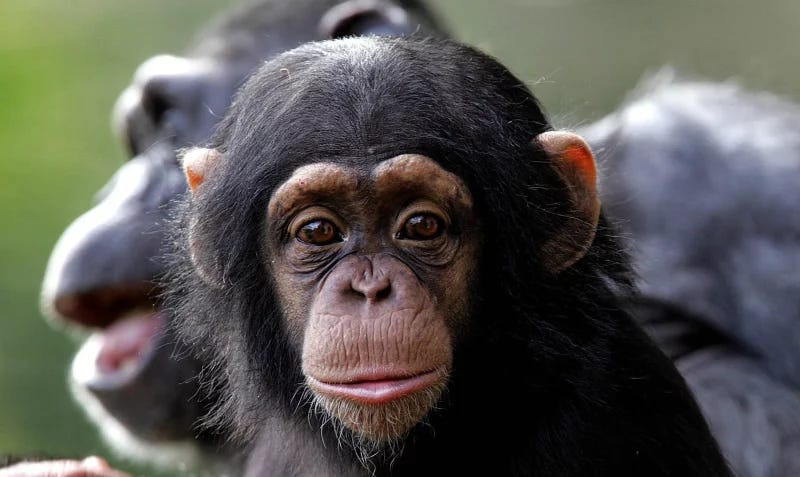
A team led by Joseph Mine at the University of Rennes examined how young chimpanzees weave together sounds, gestures, and expressions. Their study, published in PLoS Biology (2025)1, reveals that maternal lineages share distinctive “signatures” in how they combine vocal and visual signals. These patterns appear to be learned, not inherited genetically, underscoring the role of mothers as the first communication tutors.
“If your mother tends to gesticulate a lot while vocalizing, then you’re also likely to do so and your maternal siblings are also likely to do so,” said Mine. “But if that’s the case for your father, you won’t necessarily show this kind of resemblance.”
Watching the Kanyawara Chimpanzees
The research took place in Kibale National Park, western Uganda, where the Kanyawara chimpanzee community has been observed for decades. Over many months, Mine and colleagues followed the animals, filming and recording their interactions in the dense rainforest.
Chimpanzees live in fluid groups, splitting and rejoining constantly. Yet mothers and their offspring remain a reliable core. This provided a natural setting to ask whether communication patterns clustered around maternal or paternal lines.
Back in the lab, the researchers scrutinized hundreds of hours of footage. They catalogued vocalizations such as pant-hoots and soft hoos, then tracked how they were paired with gestures, facial expressions, or movements like branch slapping or reaching. The result was a repertoire of more than 100 distinct vocal-visual combinations.
A Maternal Signature
The analysis revealed something striking: individuals related through their mother produced similar numbers and styles of these combinations. In effect, families carried shared communication “signatures.” The same was not true for paternal relatives.
Because young chimps spend their formative years almost exclusively with their mothers, the findings suggest these patterns are socially transmitted, not hardwired. Exposure, not inheritance, appears to shape how a chimp weaves sound and gesture into a communicative style.
“The mother becomes a young chimp’s social template,” Mine explained. “They don’t really have the exposure that would allow them to learn from their fathers.”
Once established, these styles appear stable well into adulthood. That stability mirrors human development: children also acquire communicative habits early, shaped by those with whom they spend the most time.
Implications for Human Evolution
The discovery has implications well beyond chimpanzees. If the roots of vocal-visual learning lie in maternal care, the trait may reach back to the last common ancestor of chimpanzees and humans more than six million years ago. Other apes may share it as well.
Cat Hobaiter, a primatologist at the University of St. Andrews not involved in the study, sees the results as part of a broader picture.
“We’re seeing such similarities across the ape species,” Hobaiter said. “My bet is that we would see something similar in gorillas and orangutans. Then we’re talking about something that might be 16, 17 million years old—so long before humans were human, apes were learning socially from each other.”
The findings raise further questions. Do these maternal signatures carry meaning specific to certain families? Or do they represent broader species-wide strategies? Future work may probe whether these combinations have consistent semantic value across groups.
Why It Matters
The study highlights a continuity in the role of mothers in communication. In both chimpanzees and humans, early caregivers shape the foundations of interaction. For our ancestors, such learning may have set the stage for increasingly elaborate combinations of sound and gesture, and eventually for language itself.
As Mine put it,
“The fact that we acquire parts of our communication socially seems to be potentially a very ancient trait—a feature of our lineage for several million years.”
Related Research
Hobaiter, C., Byrne, R. W. (2011). “The gestural repertoire of the wild chimpanzee.” Animal Cognition, 14(5), 745–767. https://doi.org/10.1007/s10071-011-0409-2
Fröhlich, M., Wittig, R. M., & Pika, S. (2016). “Should I stay or should I go? Initiation of joint travel in mother–infant dyads of two chimpanzee communities in the Budongo Forest.” Animal Cognition, 19(3), 483–500. https://doi.org/10.1007/s10071-015-0940-9
Slocombe, K. E., & Zuberbühler, K. (2005). “Functionally referential communication in a chimpanzee.” Current Biology, 15(19), 1779–1784. https://doi.org/10.1016/j.cub.2005.08.068
Crockford, C., et al. (2017). “Vocal learning in the functionally referential food grunts of chimpanzees.” Current Biology, 27(14), 2177–2182. https://doi.org/10.1016/j.cub.2017.06.016
Mine, J. G., Dees, L. C., Wilke, C., Willems, E. P., Machanda, Z. P., Muller, M. N., Emery Thompson, M., Wrangham, R. W., Scully, E. J., Langergraber, K., Stoll, S., Slocombe, K. E., & Townsend, S. W. (2025). Chimpanzee mothers, but not fathers, influence offspring vocal-visual communicative behavior. PLoS Biology, 23(8), e3003270. https://doi.org/10.1371/journal.pbio.3003270


